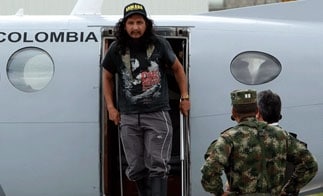The story of an Ecuadorean who was held captive by Colombia’s second-largest guerrilla army for two years sheds light on what could be a major stumbling block in upcoming peace talks: the estimated hundreds of civilians still being held by guerrilla forces.
Orlando Ibarra Sarmiento was kidnapped by the National Liberation Army (ELN) on August 2, 2010 in the southwestern Colombian province of Nariño, on the border with Ecuador. “It happened in seconds,” the 39-year-old business manager told EFE. “Three or four men in ski masks showed up at the office where I work, with a truck right there.”
Ibarra was a prisoner of the ELN for the next two years, spending much of his time in chains. His father made a ransom payment, but the guerrillas took his money then killed him, and continued to demand funds from other family members.
Ibarra’s ordeal finally came to an end on the weekend of September 8, when an ELN member who was guarding him proposed that they leave together and present themselves to authorities. According to Ibarra, the men escaped the rebel column and marched for four hours until they reached a place with cell phone reception, where they contacted the security forces.
Ibarra was reunited with relatives in Quito on September 11. Neither the fate nor identity of his captor-turned-liberator has been released by officials.
InSight Crime Analysis
Ibarra’s case highlights a major obstacle to peace talks between rebels and the Colombian government. The ELN’s guerrilla cousins in the Revolutionary Armed Forces of Colombia (FARC) are set to begin talks in early October, and the ELN’s leadership has signaled that it is also interested in negotiating with the government, but both organizations are still thought to be holding civilians kidnapped for ransom.
Historically, the FARC has been responsible for more kidnappings than the ELN. And despite a February announcement that the guerrilla group would no longer kidnap civilians for ransom, human rights organizations in the country believe that it still has anywhere between 400 to 700 civilians in captivity, many of whom may by now be dead. This was denied by alias “Rodrigo Granda,” a FARC leader who is sometimes referred to as the guerrillas’ foreign minister. On September 7, Granda told reporters in Cuba that he could swear “before the entire international community” that the group no longer has any civilian hostages, and this seems to be the guerrillas’ official position going into negotiations.
While the ELN do not admit to “kidnapping” per se, they do acknowledge abducting civilians for ransom. Just as the FARC did before its February announcement, however, the ELN justifies these kidnappings by referring to them as “retentions” of enemies of the revolution, and claim that the ransom demanded for their release is a legitimate “war tax.” According to Colombia’s Fundacion Pais Libre, which bases its numbers on government data, the ELN committed at least seven kidnappings in the first three months of 2012.
The guerrillas’ continued holding of hostages is sure to become a thorny issue for both groups as they attempt to strengthen their hands at the negotiating table. Both the ELN and the FARC have an interest in downplaying their criminal activities, while the government emphasizes them in order to cast the groups as mere criminals who have abandoned ideology in favor of illicit profits.
The groups’ denials will also make it harder for their victims and the victims’ families to obtain compensation, which is one of the six themes of the upcoming negotiations between the government and the FARC. If this latest round of peace talks is to be successful, the rebels will have to be frank about the extent of their kidnapping.

